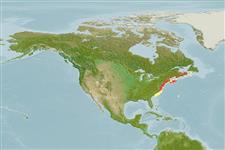Common names from other countries
Environment: milieu / climate zone / depth range / distribution range
Ökologie
seewasser; süßwasser; brackwasser benthopelagisch; anadrom (Ref. 51243); tiefenbereich 0 - 10 m (Ref. 7251). Temperate; 10°C - 33°C (Ref. 121663); 50°N - 32°N, 96°W - 59°W
North America: Atlantic Slope drainages from St. Lawrence drainage in Quebec, Canada south to Savannah River in Georgia, USA. Transplanted to Great Lakes (except Superior) and Ohio-Missouri-Mississippi river systems of mid-western USA; elsewere as far west as Colorado, USA.
Size / Gewicht / Alter
Maturity: Lm ? range ? - ? cm
Max length : 58.0 cm TL Männchen/unbestimmt; (Ref. 86798); common length : 13.5 cm TL Männchen/unbestimmt; (Ref. 12193); max. veröff. Gewicht: 2.7 kg (Ref. 120584); max. veröff. Alter: 16 Jahre (Ref. 72462)
Occurs in fresh, brackish and coastal waters (Ref. 7251). Inhabits pools and other quiet-water areas of medium to large rivers, usually over mud (Ref. 86798). Neither anterolateral glandular groove nor venom gland is present (Ref. 57406).
Assuming same mode of reproduction as in M. saxatilis.
Page, L.M. and B.M. Burr, 2011. A field guide to freshwater fishes of North America north of Mexico. Boston : Houghton Mifflin Harcourt, 663p. (Ref. 86798)
IUCN Rote Liste Status (Ref. 130435)
CITES (Ref. 128078)
Not Evaluated
Bedrohung für Menschen
Harmless
Nutzung durch Menschen
Fischereien: weniger kommerziell; Sportfisch: ja; Aquarium: Öffentliche Aquarien
Tools
Zusatzinformationen
Download XML
Internet Quellen
Estimates based on models
Preferred temperature (Ref.
115969): 4.7 - 18.2, mean 10.2 (based on 64 cells).
Phylogenetic diversity index (Ref.
82804): PD
50 = 0.5781 [Uniqueness, from 0.5 = low to 2.0 = high].
Bayesian length-weight: a=0.00447 (0.00185 - 0.01077), b=3.13 (2.91 - 3.35), in cm Total Length, based on LWR estimates for this (Sub)family-body shape (Ref.
93245).
Trophic level (Ref.
69278): 3.1 ±0.35 se; based on food items.
Widerstandsfähigkeit (Ref.
120179): niedrig, Verdopplung der Population dauert 4,5 - 14 Jahre. (K=0.07-0.13; tmax=7(?)).
Fishing Vulnerability (Ref.
59153): High to very high vulnerability (69 of 100).
Climate Vulnerability (Ref.
125649): Moderate to high vulnerability (52 of 100).
